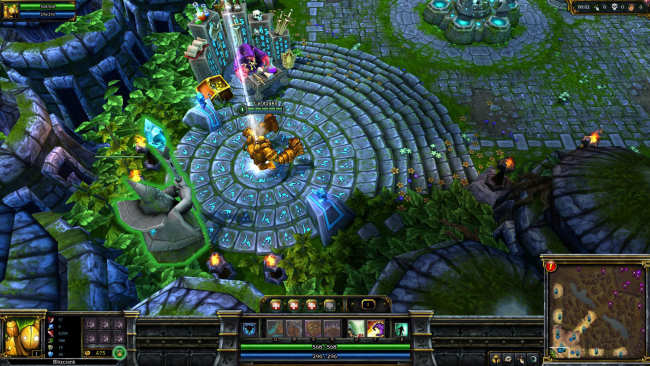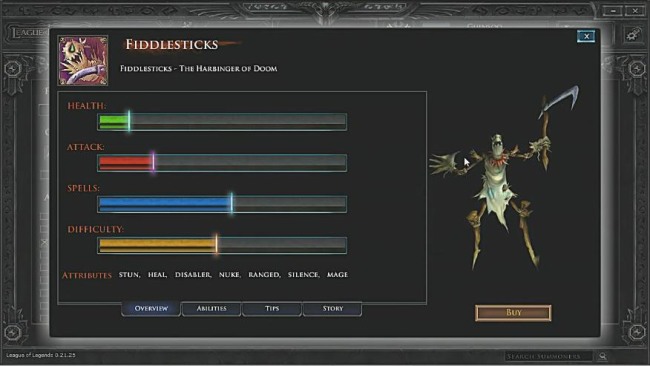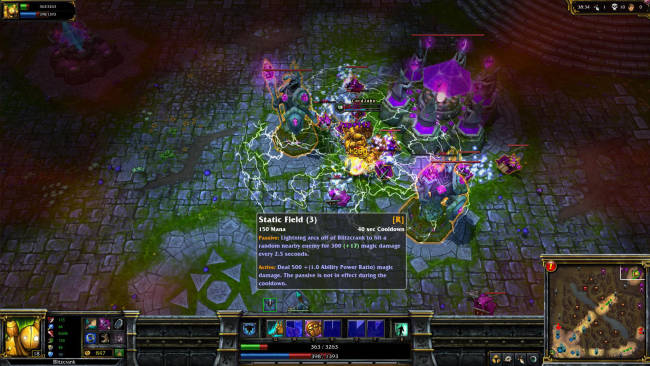Following many months of “live,” but not “ranked” gameplay, League of Legends, published by Riot Games, has gone pro, launching their competitive Season One. Featuring several ranked ladder modes: “solo” (actually solo or duo play) 5v5, full premade 5v5 and full premade 3v3, the ladders will culminate with tournament play and $100,000 of cash and prizes. Although Riot will not release simultaneous usage numbers, they have confirmed through various online sources they have over 3 million registered accounts. With the DOTA community estimated at 7-9 million players built over a decade, Riot should be proud of how quickly their game has caught on and distinguished itself in broad field of incumbents and competitors.
Unsurprisingly, Season One is mostly more of the same. On the cosmetic side, both the website and the game’s launcher UI received new snazzy themes and sound track. For the game itself, beyond the usual patch changes of balance tweaks and a new hero, a draft mode was implemented for competitive play. This mode includes alternating bans of 4 champions, 2 for each team, followed by a staggered draft. Unlike normal games, champions also must be unique, meaning that opposing teams cannot select the same champion. This introduces an important strategic element, and also gives Riot a useful tool for determining balance, as the most commonly banned heroes indicate the desires and irritants of the player base.

Season One is quite the culmination of achievement for a relatively new game. In an era of MMOs and FPS with online components, LoL stands in a unique place, both as a free game that isn’t text based or mature and a new entrant. It is a pity that Riot will not release usage numbers, as it is quite possible that the LoL is setting a variety of records, particularly in the realm of “free to play games”. Which brings up an important point: even in a perfect world, Season One is somewhat uncharted territory and ultimately a beta for future seasons to come.
Accordingly, things haven’t been perfect, but for the most part, they’ve gone well. One speed bump was a nasty bug on the first day that left players unable to select their champions, leading to disqualification and a loss. Riot did not announce this bug to the public, despite a slew of threads in the bug forum, but they did confirm its existence to me and its subsequent hot fixing the same evening as launch. There were, however, no efforts made to remediate losses from it. While minor in the scheme of things, losing because of a bug was not how people (myself included) wanted to start their competitive experience, – in fact, I suffered said bug from my first game.
Additionally, server lag has often been quite poor, although it has improved recently. This is a bit of a shock, as LoL prides itself on server side connections and typically strong performance. With usage numbers likely at an all time high – finding games takes half to a fourth of the time it did prior to Season 1 – a certain amount of lag could be anticipated as part of the launch. However, beyond some glib comments from various Riot employees on the forums, the company has not acknowledged the problem formally, nor given its causes. Anecdotally, it appears to have improved over the first few weeks, but whether this is from additional server capacity or reduced usage is unknown.

Riot has been more open and aggressive in improving other issues around the launch. They’ve identified certain bugs that remain and made them clear to the community. They’ve also been very aggressive in curbing negative player behavior, at least to the extent this is possible on the internet. A publicized campaign of banning players who enjoy being asshats, be it intentionally poor game performance or asinine behavior, has been executed, resulting in suspensions and bans of hundreds of accounts.
Another item of note is that Riot has been willing to aggressively alter Season One’s structure to support game quality. Initially, players from level 20-30 (30 is the current level cap) were allowed to participate in Season One. However, data revealed that players 20-29 were dramatically more likely to quit on games, so Riot moved within the first week to bring the cutoff to 30 to increase game quality. They are, however, considering lowering the cap for arranged teams, so that people can more easily play with their friends, under the premise friends are less likely to quit on each other. This sort of firm and decisive action, backed by hard data, is indicative of a developer that has a handle on their community.
Overall, Season One of LoL is an impressive achievement that will likely set the stage for the game’s continued reign over DOTA and its clones and carve a out a niche among the gaming industry as a whole. The launch has also served to provide significant insight into Riot as a company. On the strong side, as previously mentioned, the company is very clearly composed of gamers who understand the community and the game itself at a practical level. There is a strong community presence – from community relations employees to programmers – that reflects a work place that is creative and “gets it.”

On the weak side, Riot exhibits some of the same traits we see from larger companies: a willingness to ignore certain noticeable errors and failures, even in the face of their existence (bugs, lag), with the (presumed) hope that the overall strength of the game will carry the day. Another example: the elusive Mac client. An earlier press release indicated that it would arrive in time for Mac users to play in Season One. Although the release did not explicitly indicate perfect overlap with Season One, there has been no word of the Mac client lately. Where did it go?
LoL is well worth any gamers’ time, especially since it comes at the low price of “free.” The bigger question, which perhaps is only relevant to postulating bloggers and game reviewers, is if Riot is interested in doing business in an open manner, or if they will follow the tried and true Blizzard business model of “awesome product, and the rest doesn’t matter.” In this day and age, it probably doesn’t matter: gamers who can walk away with a good game should be happy, because even that is a rarity. And League of Legends is absolutely a good, if not great, game.

